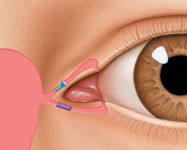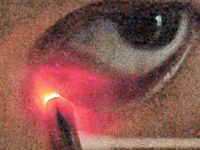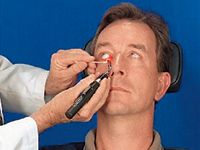Article
Consider the cause when treating late-onset epiphora following occlusion therapy
Rather than jumping immediately to an aggressive management approach, clinicians should consider the simpler and less-invasive procedures described here.

Offer more occlusion If the epiphora is episodic, varying from day to day or even resolving altogether for hours on end, suspect the cause to be persistent dry eye syndrome with resultant reflex tearing. In moderate-to-severe dry eye it is sometimes necessary to occlude not only two, but all four canaliculi.
Should undertreatment prove to be the concern, corrective action aims at: 1) confirming the presence of the previously inserted plugs, and providing additional occlusion therapy in an unoccluded lacrimal system, or 2) confirming the absence of previously inserted plugs, and re-treating the patient with occlusion therapy (may need to use a larger-diameter plug).

Canalicular obstruction If the epiphora has a more persistent and continuous course, it is more likely that complete canalicular obstruction is to blame. During the blink, debris and lashes are carried by the tear film away from the ocular surface and down into the lower canalicular system. In the presence of a lacrimal plug (and sometimes even in the absence of one) these waste materials can collect, forming a meshwork across the canaliculus. With ingrowth of epithelial cells and neovascularization, a complete canalicular obstruction may develop, with resultant epiphora. Strictures or epithelial adhesions may also occur, with or without the presence of a plug, that occlude the lacrimal system. These adhesions may make it difficult to pass saline, let alone instruments.
Having determined that a canalicular obstruction exists (may or may not include the presence of a lacrimal plug), take conservative steps first before turning to more invasive surgical procedures (such as silicone-stent insertion, dacryocystorhinostomy [DCR], Jones-tube insertion, or balloon dacryoplasty).
Ideally, surgeons will resolve the unwanted epiphora, minimize undue surgical risk, and ensure that the patient continues to benefit from occlusion therapy.

A solution to this is to use a cannula, advanced to the site of the obstruction, to flood the canaliculus with topical anti-inflammatory medication, and then treat the patient with a regimen of topical anti-inflammatory medication for 10 to 14 days. In many patients, irrigation of an occluded lacrimal system becomes possible following such treatment; it is suggested that the patient continue with the topical treatment for 7 to 10 days following irrigation to ensure continued patency. This technique is also useful in primary obstructions of the lacrimal system in the absence of plugs.
Newsletter
Don’t miss out—get Ophthalmology Times updates on the latest clinical advancements and expert interviews, straight to your inbox.





